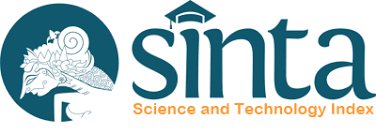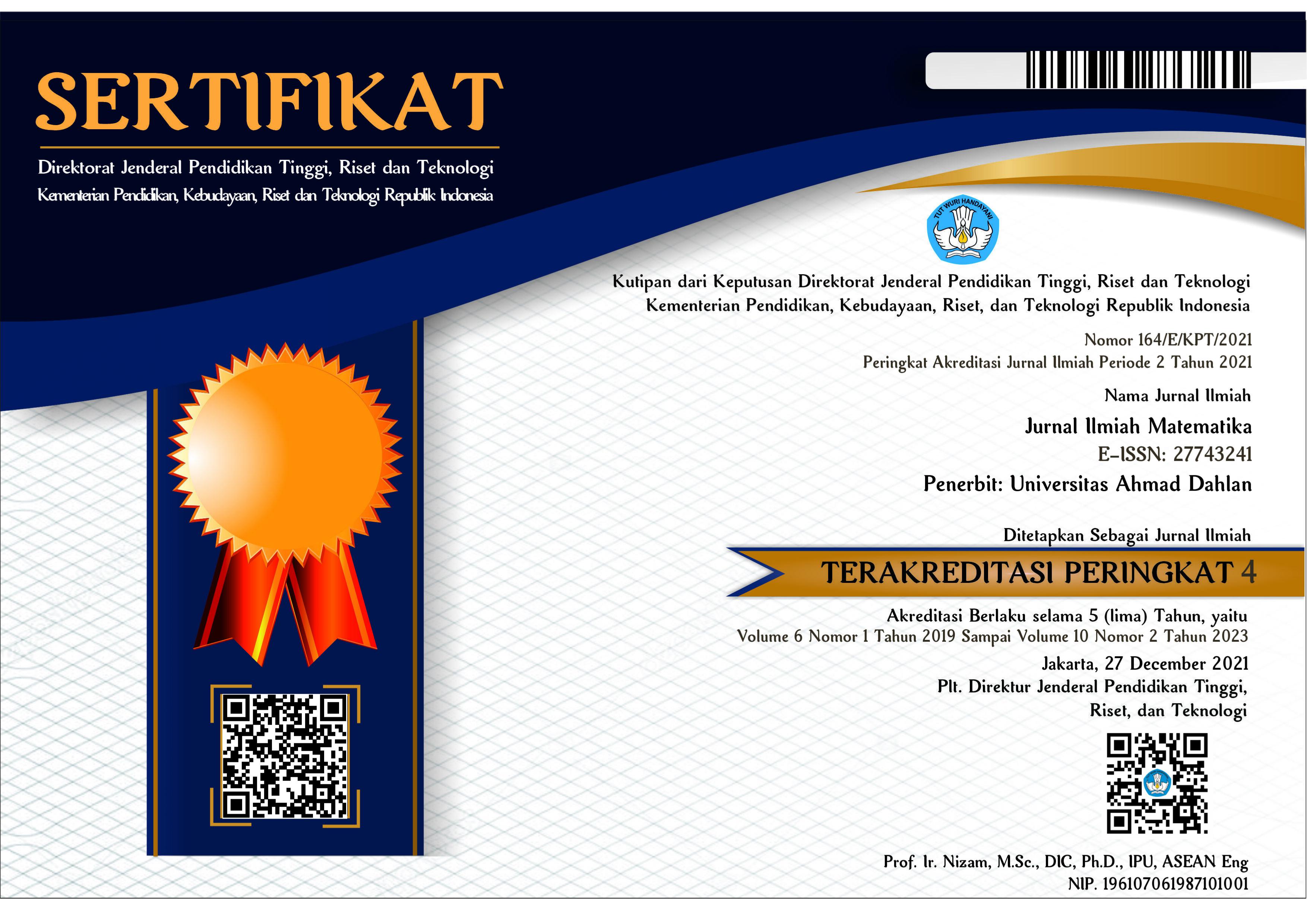Peramalan curah hujan di kota bandung menggunakan singular spectrum analysis
DOI:
https://doi.org/10.26555/konvergensi.v0i0.21461Keywords:
SSA, Peramalan, Curah HujanAbstract
Curah hujan merupakan fenomena alam yang selalu terjadi di Indonesia setiap tahunnya. Fenomena ini bisa saja menyebabkan bencana seperti banjir dan tanah longsor. Adanya peramalan sangat dibutuhkan sebagai bentuk peringatan dini mengenai kondisi di waktu yang akan datang. Singular Spectrum Analysis (SSA) merupakan suatu teknik analisis deret waktu dan peramalan. SSA bertujuan untuk menguraikan deret waktu asli menjadi sejumlah kecil komponen yang dapat diinterpretasikan menjadi tren, osilasi dan noise. Tujuan dari penelitian ini yaitu menyajikan model peramalan curah hujan di Kota Bandung menggunakan metode Singular Spectrum Analysis (SSA). Berdasarkan penelitian ini, diketahui bahwa data curah hujan di Kota Bandung memiliki pola musiman. Penentuan window length (L) dilakukan dengan trial and error, yang dalam kasus ini diperoleh window length 17. Melalui dekomposisi dan rekonstruksi dengan window length 17 diperoleh 4 pengelompokan, yaitu satu kelompok tren dan tiga kelompok musiman. Pada penelitian ini digunakan RMSE untuk mengukur kesalahan hasil peramalan. Berdasarkan hasil pengujian dengan metode Singular Spectrum Analysis (SSA) diperoleh RMSE sebesar 167,510.References
N. Ihsan and S. Sulistiawaty, “Analisis pola dan intensitas curah hujan berdasakan data observasi dan satelit tropical rainfall measuring missions (trmm) 3b42 v7 di makassar,†J. Sains dan Pendidik. Fis., vol. 11, no. 1, 2015.
C. C. Nwokike, B. C. Offorha, M. Obubu, C. B. Ugoala, and H. I. Ukomah, “Comparing SANN and SARIMA for forecasting frequency of monthly rainfall in Umuahia,†Sci. African, vol. 10, p. e00621, 2020, doi: https://doi.org/10.1016/j.sciaf.2020.e00621.
C. A. F. Marques et al., “Singular spectrum analysis and forecasting of hydrological time series,†Phys. Chem. Earth, Parts A/B/C, vol. 31, no. 18, pp. 1172–1179, 2006.
D. Ruhiat, D. Andiani, and W. N. Kamilah, “Forecasting data runtun waktu musiman menggunakan metode singular spectrum analysis (ssa),†Teorema Teor. dan Ris. Mat., vol. 5, no. 1, pp. 47–60, 2020.
W. Puspitasari, S. Rustiana, Y. Suparman, and T. Purwandari, “perbandingan hasil peramalan curah hujan bulanan kota bogor dengan seasonal autoregressive integrated moving average (SARIMA) dan singular spectrum analysis (SSA),†Pros. SENDIKA, vol. 5, no. 2, 2019.
A. R. Khan and H. Hassani, “Dependence measures for model selection in singular spectrum analysis,†J. Franklin Inst., vol. 356, no. 15, pp. 8906–8928, 2019, doi: https://doi.org/10.1016/j.jfranklin.2019.08.033.
Y. Zhang, J. Le, X. Liao, F. Zheng, and Y. Li, “A novel combination forecasting model for wind power integrating least square support vector machine, deep belief network, singular spectrum analysis and locality-sensitive hashing,†Energy, vol. 168, pp. 558–572, 2019, doi: https://doi.org/10.1016/j.energy.2018.11.128.
J. Guo, K. Shi, X. Liu, Y. Sun, W. Li, and Q. Kong, “Singular spectrum analysis of ionospheric anomalies preceding great earthquakes: Case studies of Kaikoura and Fukushima earthquakes,†J. Geodyn., vol. 124, pp. 1–13, 2019, doi: https://doi.org/10.1016/j.jog.2019.01.005.
Y. Xie, J. Zou, C. Peng, Y. Zhu, and F. Gao, “A novel PEM fuel cell remaining useful life prediction method based on singular spectrum analysis and deep Gaussian processes,†Int. J. Hydrogen Energy, vol. 45, no. 55, pp. 30942–30956, 2020, doi: https://doi.org/10.1016/j.ijhydene.2020.08.052.
M. Škare and M. Porada-Rochoń, “Multi-channel singular-spectrum analysis of financial cycles in ten developed economies for 1970–2018,†J. Bus. Res., vol. 112, pp. 567–575, 2020, doi: https://doi.org/10.1016/j.jbusres.2019.10.047.
Y. Lu, X. Zhang, L. Jing, X. Li, and X. Fu, “Estimation of the foetal heart rate baseline based on singular spectrum analysis and empirical mode decomposition,†Futur. Gener. Comput. Syst., vol. 112, pp. 126–135, 2020, doi: https://doi.org/10.1016/j.future.2020.05.008.
Y. Lin, B. W.-K. Ling, N. Xu, R. W.-K. Lam, and C. Y.-F. Ho, “Effectiveness analysis of bio-electronic stimulation therapy to Parkinson’s diseases via joint singular spectrum analysis and discrete fourier transform approach,†Biomed. Signal Process. Control, vol. 62, p. 102131, 2020, doi: https://doi.org/10.1016/j.bspc.2020.102131.
H. Liu, X. Mi, Y. Li, Z. Duan, and Y. Xu, “Smart wind speed deep learning based multi-step forecasting model using singular spectrum analysis, convolutional Gated Recurrent Unit network and Support Vector Regression,†Renew. Energy, vol. 143, pp. 842–854, 2019, doi: https://doi.org/10.1016/j.renene.2019.05.039.
M. F. Akhter, D. Hassan, and S. Abbas, “Predictive ARIMA Model for coronal index solar cyclic data,†Astron. Comput., vol. 32, p. 100403, 2020, doi: https://doi.org/10.1016/j.ascom.2020.100403.
A. Shadab, S. Ahmad, and S. Said, “Spatial forecasting of solar radiation using ARIMA model,†Remote Sens. Appl. Soc. Environ., vol. 20, p. 100427, 2020, doi: https://doi.org/10.1016/j.rsase.2020.100427.
J. J. Selvaraj, V. Arunachalam, K. V. Coronado-Franco, L. V. Romero-Orjuela, and Y. N. RamÃrez-Yara, “Time-series modeling of fishery landings in the Colombian Pacific Ocean using an ARIMA model,†Reg. Stud. Mar. Sci., vol. 39, p. 101477, 2020, doi: https://doi.org/10.1016/j.rsma.2020.101477.
Downloads
Published
Issue
Section
License
Authors who publish with this journal agree to the following terms:
1. Authors retain copyright and grant the journal right of first publication with the work simultaneously licensed under a Creative Commons Attribution License that allows others to share the work with an acknowledgment of the work's authorship and initial publication in this journal.
2. Authors are able to enter into separate, additional contractual arrangements for the non-exclusive distribution of the journal's published version of the work (e.g., post it to an institutional repository or publish it in a book), with an acknowledgment of its initial publication in this journal.
3. Authors are permitted and encouraged to post their work online (e.g., in institutional repositories or on their website) prior to and during the submission process, as it can lead to productive exchanges, as well as earlier and greater citation of published work.

This work is licensed under a Creative Commons Attribution-ShareAlike 2.0 Generic License.









